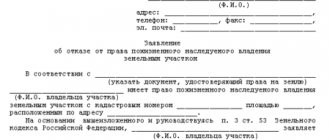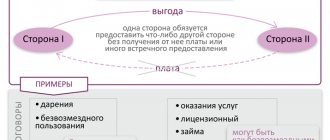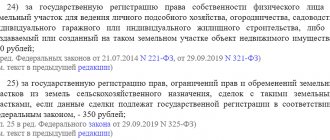How to properly register a plot of land
Registration of property rights gives complete freedom to dispose of land: sale, inheritance or gift, as well as protection of one’s rights in disputes with neighbors or local authorities. According to the Land Code, any citizen of the Russian Federation can register land for free once in their entire life.
In the future, registration for individuals, for repeated applications, will be paid, as for legal entities. You can register a land plot as joint, shared or sole ownership. For registration of plots, the legislation establishes certain restrictions ─ land in the territory of parks, cemeteries, and state reserves is not registered under this law. It is also impossible to privatize lands that have been withdrawn from circulation: the territory where nuclear energy facilities are located, plots of land of the armed forces.
How to register a leased plot as property
According to Federal Law No. 178 “On State Social Assistance,” a citizen has the right to register a leased land plot as his own, i.e. privatize land that was originally leased (indefinitely or urgently).
You can register a plot for free if:
- You have built a country house, bathhouse, garage or outbuilding and become the owner of the property;
- You have built and become the owner of a private house;
- You are a member of a gardening cooperative.
You can get a plot of land for free if you are related to the following categories of citizens:
- Disabled people;
- BOB Veterans;
- Orphans;
- Large families;
- Military personnel who served more than 10 years;
- Police officers with more than 15 years of experience;
- Young agricultural workers;
- and other categories of beneficiaries.
You can also get land for free if the ownership of the house was registered before 10/30/2001.
To register ownership of a plot of land under lease, you must submit an application with an extract from the cadastral plan to the local municipal authority in charge of the land. Depending on the circumstances, the administration may make the following decisions:
- Transfer ownership of land free of charge, while issuing a permit in the prescribed form;
- Offer to buy the land and submit a purchase and sale agreement for consideration, and after the purchase, register the site;
- Reject the application if you do not have the rights of the owner (in accordance with Article 28 of the Land Code), or the site was not used for its intended purpose.
In general, the further procedure for registering a leased plot as a property does not differ from the usual one. The required documents will only be supplemented with a municipal permit (or a purchase and sale agreement).
Documents for land privatization
If the package of documents is completed correctly, registration of ownership of a land plot takes place quite quickly: up to 30 days from the date the applicant submits the documents and the corresponding application. To complete the procedure, you need to submit a package of documents to the registration authority:
- owner's passport;
- receipt of payment of state duty;
- a purchase and sale agreement, a certificate of inheritance, an order for the allocation of a plot, a resolution for the provision of a plot, a court decision recognizing ownership or other title document;
- cadastral plan of the site;
- application for state registration of the site.
It is not always possible to collect documents quickly, so the registration procedure is delayed. This is due to the fact that many owners do not have a title document and a cadastral passport. Especially those who purchased their land before 2001, when the Land Code with a simplified registration system came into force. (According to the calculations of realtors, before the adoption of the law, it was necessary to apply to 15 authorities to register land rights!) Even if all the documents are available, but they were prepared a very long time ago and according to outdated rules, there is no complete information for registering a plot, which can delay registration .
Why do I need a registration certificate?
This certificate is an important component of the entire package of documents, because it is what gives the buyer the right to subsequently dispose of his purchase as he wishes.
It also confirms that all rules and regulations regarding the execution of the transfer of rights to real estate have been complied with.
A certificate of land ownership is issued by Rosreestr.
This government agency enters data about the land plot and its owner into a national database, after which it hands over a document confirming the successful result. Attention! The registration process itself is quite easy and fast.
The main thing is to adhere to the basic rules for collecting documents and drawing up an application specified in the current legislation. Before starting the procedure for registering property rights, employees of this institution check the accuracy and compliance of all submitted papers, and therefore, after registration, it is virtually impossible to challenge the purchase through the courts.
The certificate must contain information about:
- type of land plot;
- its size;
- owner;
- cadastral number, etc.
This document not only confirms the right to property, but also allows in the future to enter into transactions with legal entities and individuals regarding the lease of a land plot or its sale. Also, based on the certificate, the subject can use the land as collateral when applying for a loan or mortgage.
Important! There is a certain category of land plots, the exploitation of which is possible only for certain purposes, and therefore even the existence of ownership rights cannot cause a violation of the provisions provided for in the current legislation.
Obtaining a cadastral plan
The sequence of actions when receiving a cadastral plan is as follows: the owner of the plot submits an application, a passport and a receipt for payment of the state duty to the cadastral authority. When registering ownership of a land plot, the state duty for individuals today is only 200 rubles.
If the boundaries of the site are known and the cadastre contains all the necessary information, then it is quite possible to obtain such a plan in 10 days.
The situation becomes more complicated if some of the information necessary for privatization is missing in the cadastre. Then the cadastral authority refuses to accept the documents, but always issues a certificate with a list of missing materials for drawing up a standard cadastral plan.
To clarify the boundaries of his plot, the owner, at his own expense, carries out a land surveying procedure ─ finds a commercial company with the appropriate license and enters into an agreement with it. Land surveying ─ description of the territory with marking of its boundaries ─ is carried out by professionals, because land surveying ─ is the collection of information, processing of documentation related to the use of the site, drawing up a plan where all objects should be displayed. These works require both financial and time resources. As part of land management work, the land owner must coordinate its boundaries with its neighbors. If it is not possible to reach an agreement with the owners of neighboring territories, the dispute will be resolved by the court. When all the necessary land management work has been completed, the owner of the plot must again contact the cadastral authority. List of documents for a cadastral passport:
- description of the site;
- title document;
- request for cadastral registration.
Registration in the cadastre is carried out 30 days in advance (there are no additional costs here), then a cadastral extract or passport for the site is issued.
Procedure for paying state duty
The state duty is paid in the amount established by the Tax Code of the Russian Federation.
This procedure is paid for before the provision of services in two ways:
- Cash;
- Through the bank;
- Through a special payment terminal installed either in the MFC or in Rosreestr.
The fact of payment is confirmed by a receipt of the appropriate sample. The fee can be 350 rubles for an individual and a private plot, for registering property on a leasehold basis - 2000, for legal entities - 22,000 rubles. This is a mandatory payment.
Obtaining a title document
Until 2011, land issues in the Russian Federation were not 100% regulated by law, so many land owners do not have title documents. Together with the land plot, summer residents then received only a gardener's membership card. Registration of ownership of a land plot in 2014 is possible in several options:
- you can try to find the seller of your plot, draw up a power of attorney with him and draw up a purchase and sale agreement according to the new rules;
- prove the fact of purchase and sale of a plot in court in order to obtain a title document. The court will require additional arguments: a membership book, witness testimony, payment documents confirming the availability of regular membership fees, an administration resolution assigning the land plot to the owner;
- if the land plot is allocated not to a specific person, but to a gardening partnership, then first you need to privatize the land to the collective owner, and then deal with land surveying and registering it as property.
After receiving the documents, you can go to the registration authority. To register collective property, a decision must be made at a general meeting with the submission of a collective application to the administration. In addition to the application, you also need an act on land allocation with a boundary plan, a diagram of the boundaries of individual plots as part of the common property and an act securing each plot, a general plan for the entire area. Additionally, the company provides the territorial administration with statutory documents, an extract from the Unified State Register of Legal Entities, as well as a certificate of state registration of the company.
The administration is obliged to issue an order on the allocation of land and approve the plan for the boundaries of public property within 30 days. This order is the basis for land surveying of all areas.
In reality, all procedures (including land surveying and obtaining a cadastral passport) take six months. The next step is registration of ownership of a common land plot, which takes up to 30 days. At the last stage, each owner of a land plot registers it as individual property.
How to obtain land ownership?
In order to obtain ownership of land, it is necessary to determine how this land can become the right of ownership: this is an inheritance or purchase and sale, or privatization; it is possible to transfer the land as authorized capital. This is one of the main stages. Next, the necessary documents are drawn up and submitted to Rosreestr.
Is it necessary to register the right to a land plot?
Next, for any type of transfer of ownership, registration follows, since it is mandatory for all types of procedures with land. This is a general rule, since it gives the right to dispose of the land itself, so that various legal transactions can be made with this land. To do this, it is necessary to register in accordance with all currently existing standards. Each individual case has its own peculiarities in the design of this right.
What is prohibited from being transferred to private property?
In the Land Code of the Russian Federation in paragraph 4 of Art. 27 and in paragraph 8 of Art. 28 of the Federal Law of December 21, 2001 No. 178-FZ there is a list of plots of land that are withdrawn from general circulation; ownership cannot be registered on them:
- Nature reserves protected by the state;
- National parks;
- Military buildings;
- Court buildings;
- FSB facilities;
- Places where nuclear waste is stored;
- Communication lines;
- Areas registered by the Forest Fund or having water bodies;
- Lands with cultural heritage;
- Cemeteries;
REFERENCE. The Land Code of the Russian Federation has some reservations according to which the lands of national parks and natural reserves can be owned by an individual or legal entity, which are enshrined in Article 93. ZK RF.
Registration of "self-capture"
In the process of land surveying work, it sometimes turns out that the actual size of the plot and the one indicated in the documents do not coincide. The reasons for this phenomenon are that in the recent past they were not particularly worried about the accuracy of measurements, so out of six hundred square meters one person got five and a half, another six and a half. Sometimes the owner himself, when installing a fence, reserved excess space or appropriated an ownerless vacant lot behind the house. Unregistered lands are legalized simultaneously with the legal plot, but only when the neighbors have no complaints about this. If the plot has increased at the expense of neighboring properties, then the neighbor must give written confirmation that he is not against such adjustments. Otherwise, only the court can solve the problem. If the site is expanded at the expense of a road or the outskirts of a forest or meadow, it must be agreed with the local authorities. And she won’t like every “squatter” ─ here they are guided by regional regulations. Such strict measures apply more to places where land is scarce and of great value. But in the provinces, where there are many kilometers of unplowed and untrodden areas, everything is solved more easily.
Registration of a site without land surveying
If ownership was registered before 1998. or not registered at all, then it can be registered without land surveying. For those who have a certificate issued by the Main Directorate of the Federal Registration Service, this information is not relevant.
The obvious benefit of this form of registration is the opportunity to save up to 15 thousand rubles on land surveying, because in some regions the cost of land management work approaches the cost of the land plot itself. The output is a certificate of state registration of rights of a new type, which allows you to freely dispose of the site. The cadastral passport of the plot is obtained from the island. The disadvantage of such savings is that it is more difficult to find a buyer for a “pig in a poke”. The plot can be left in the bank as collateral, but experts do not recommend registering the land using this option. By spending money on land surveying, in the future you can save yourself from problems when selling or donating.
In practice, this form of site registration does not always work. Authorities refuse to transfer ownership rights if the site has not undergone the land surveying procedure. The motivation for refusal is the uncertainty of the object that the applicant is asking to register. This position is often supported by the courts, recognizing the actions of government authorities as lawful, although the legislation does not require clarification of boundaries when registering property rights.
To save money and time in the future, when submitting a survey file, you can also order 2 copies of the cadastral extract along with the cadastral passport. Now these documents can be obtained for free, but later you will have to pay.
Registration of ownership of a land plot without land surveying:
We study the legal documents. If the certificate is an old one, then there will certainly be a link to the main document. An extract from the household register is issued by the local administration, and resolutions are issued in the archive. This step takes from a week to a month.
We collect a package of documents: title documents, an old-style certificate (sometimes you don’t need to show it at all) and send it to the cadastral chamber. A month later they issue a cadastral passport from the island. The cadastral passport is ordered in two copies. The assigned cadastral number is indicated in the application to the administration when specifying the address, intended purpose and category of the site.
We find in the documents the category, address, and intended purpose of the land. According to the Land Code of 2001, the main characteristics are the category and intended purpose of the site. These characteristics may need to be clarified; you should also inquire with the local administration about the need to clarify the address of the site. This stage can take more than a month. Applications must indicate the assigned cadastral number.
We submit the following documents to the registration chamber:
- owner's passport;
- cadastral passport;
- title documents.
The deadline for registering ownership of a new type of land plot is 1 calendar month. Except for individual construction projects, for which the deadline is set until 01.03. 2015, the dacha amnesty for registration of ownership of plots of land is unlimited.
What information is contained in the certificate
The certificate of ownership must necessarily contain information about:
- government bodies that completed the registration procedure;
- the date of delivery of this document;
- the document on the basis of which this right was transferred to the applicant;
- the owner of the land plot;
- size and category of territory;
- subsequent exploitation of the land;
- cadastral number.
Attention! When signing agreements on the lease of a land plot, its sale or donation, it is necessary to present a cadastral passport together with the certificate.
The registration process itself is quite quick and simple, but collecting documents to obtain a certificate usually takes a lot of time, especially if the owner of the acquisition has no idea how exactly this stage is carried out and what requirements are established by law regarding the preparation of papers. To get the desired result and save your own time and effort, you should contact a law office that will help you prepare all the necessary documents and correctly fill out the application form.
Registration of a plot received by inheritance
As you know, land rights are registered in different cases:
- If the owner has the right of perpetual use (he once received a plot of land from a factory or cooperative).
- If there is a land lease agreement concluded with the local administration.
- If the owner of the plot has the right of lifelong ownership or the land belonged to parents, spouse, children, then the plot is automatically inherited, even if there are no documents for it.
If a land plot is inherited according to a will, then registering it as property is an extremely simplified procedure. According to Art. 1181 of the Civil Code of the Russian Federation, citizens have the right of inheritance, and additional procedures for registering a plot of land as their property are not necessary. This right also applies to all buildings erected on the site, as well as natural subsoil. The procedure for registering ownership of a land plot transferred by inheritance:
Open an inheritance case with a notary
Within six months after the death of the testator, fill out an application from a notary to accept the inherited land plot. The notary issues a power of attorney for conducting inheritance business, which will help collect documents:
- cadastral passport and site plan as of the date of death of the testator;
- extract from Rosnedvizhimost;
- statement about the absence of buildings on the site;
- technical specifications;
- an extract from the Unified State Register for the testator (form No. 3), which indicates what kind of real estate the testator had;
- market valuation and agreement on the provision of valuation services for the site, which is ordered from any specialized company that has a license;
- a certificate of the last place of registration of the testator (a court decision establishing the fact of opening an inheritance with a note about its entry into legal force);
- extract from the land registry;
- birth certificate, marriage certificate, registry office certificate with copies - or other documents confirming family relationships;
- six months after the death of the testator, a court decision will be required to establish the fact of acceptance of the inheritance;
- a will with a notary’s note indicating where it was drawn up;
- a certificate from the tax office if the testator received the plot as an inheritance or as a gift;
- if the site is used as a summer cottage, then the Charter of the garden community is required.
Get a certificate
After closing the inheritance case, they receive from a notary a certificate for the plot confirming the right to inheritance. Each heir receives a separate certificate.
Register a certificate
To register a certificate issued by a notary to an heir, you must contact the registering authority (UFRS or MFC), pay a state fee of 1000 rubles, and prepare the following documents:
- owner's passport;
- application for registration of land rights;
- cadastral passport for the plot;
- certificate of inheritance;
- death certificate of the testator.
The registrar takes the documents submitted for registration and issues a receipt with the date of receipt of the certificate: at most - 7 - 10 days. Each heir is given his own certificate.
How does registration work?
The main government agency regulating issues related to entering real estate data into the state registration database is Rosreestr. https://fizzslots.games
The procedure itself consists of the following steps:
- Submission of the collected documents for preliminary verification (workers check whether all the necessary papers are present, and if one of the documents is missing, they indicate what else needs to be prepared to begin the process).
- Transfer of documents to the authorized state body.
- Conducting a detailed review of all papers, checking the accuracy and legality of each of them.
- Entering data into a common database.
- Presentation of the registration certificate.
Attention! If one of the documents turns out to be incorrectly executed or contradicts current legislation, then Rosreestr will refuse your request for registration.
As for time restrictions, the process itself lasts for 10 working days. In rare cases, it may exceed this limit. The certificate indicates the date of filing the petition, and therefore, even if the result becomes known two weeks later, the right to property will be valid from the date of filing the documents.
Assistance in privatization
The new law provides land owners with some relaxations, but the registration procedure has not become completely simple: you have to obtain documents from your administration, find land surveyors, wait for the survey results, agree on all the “extra” acres, fill out and submit declarations, wait for a certificate... For those who have their time values more than money, there is another option for acquiring land ─ easier, faster, but more expensive.
You can entrust the collection of documents to real estate or law firms that provide similar services and promise to solve any registration problem at any stage of registration, from collecting missing documents to turnkey registration. But this is quite an expensive pleasure. The price depends on what documents the owner of the site already has in his hands and what real estate transactions he intends to carry out. Thus, obtaining a cadastral passport through intermediaries in Moscow will cost 7,000 rubles, registration of buildings under the “dacha amnesty” will cost 15,000 rubles, and registration of a complete set of turnkey documents, as well as registration of inheritance for land, will cost 40,000 rubles. They promise to visit the customer and provide consultations at all stages free of charge.
Registration of ownership of a land plot has many nuances and requires compliance with the rules and regulations of the law. A lack of knowledge in this area can increase both the time and financial costs of land privatization, so you need to prepare for this procedure in advance by carefully studying the regulations and consulting with an experienced lawyer.
Simplified registration of land ownership
To register a dacha or garden plot, there is a simplified procedure for registering property rights, which is also called the “dacha amnesty”.
It lies in the fact that every citizen can privatize a dacha plot, as well as register capital construction projects as residential premises, which makes it possible to register on a dacha plot. This way you can write:
- Land plots for gardening, vegetable gardening, subsidiary and dacha farming, construction of a garage or residential building (then, according to the simplified registration procedure, only those houses whose construction began before March 1, 2019 are subject to registration).
- The buildings themselves on these sites are country houses, bathhouses and more.
The simplified procedure was in effect until the end of 2021, but it was recently extended until March 1, 2026.







